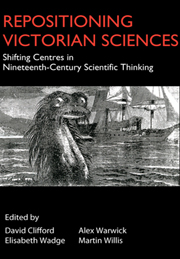1 - Margins and Centres
Published online by Cambridge University Press: 05 March 2012
Summary
In 1859, Prince Albert addressed the British Association for the Advancement of Science (BAAS) as its President and attempted to assess the place of science in the modern State. In his description of science, he says:
The operation of Science then has been, systematically to divide human knowledge, and raise, as it were, the separate groups of subjects for scientific consideration, into different and distinct sciences. The tendency to create new sciences is particularly apparent in our present age, and is perhaps inseparable from so rapid a progress as we have seen in our days; for the acquaintance with and mastering of distinct branches in knowledge enables the eye, from the newly gained points of sight, to see the ramifications into which they divide themselves in strict consecutiveness and with logical necessity. But in thus gaining new centres of light, from which to direct our researches, and new and powerful means of adding to its ever-increasing treasures, Science approaches no nearer to the limits of its range, although travelling further and further from its original point of departure.
A little over a year later Albert was dead, but his vision of the material location for the operations of science was beginning to be accomplished.
- Type
- Chapter
- Information
- Repositioning Victorian SciencesShifting Centres in Nineteenth-Century Thinking, pp. 1 - 14Publisher: Anthem PressPrint publication year: 2006



